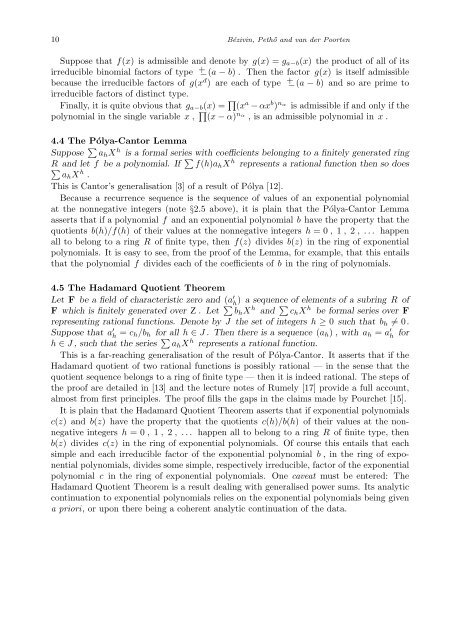A FULL CHARACTERISATION OF DIVISIBILITY SEQUENCES ...
A FULL CHARACTERISATION OF DIVISIBILITY SEQUENCES ...
A FULL CHARACTERISATION OF DIVISIBILITY SEQUENCES ...
You also want an ePaper? Increase the reach of your titles
YUMPU automatically turns print PDFs into web optimized ePapers that Google loves.
10 Bézivin, Pethő and van der Poorten<br />
Suppose that f(x) is admissible and denote by g(x) =ga−b(x) the product of all of its<br />
irreducible binomial factors of type + −(a − b) . Then the factor g(x) is itself admissible<br />
because the irreducible factors of g(x d ) are each of type + −(a − b) and so are prime to<br />
irreducible factors of distinct type.<br />
Finally, it is quite obvious that ga−b(x) = (x a − αx b ) nα is admissible if and only if the<br />
polynomial in the single variable x , (x − α) nα , is an admissible polynomial in x .<br />
4.4 The Pólya-Cantor Lemma<br />
Suppose ahX h is a formal series with coefficients belonging to a finitely generated ring<br />
R and let f be a polynomial. If f(h)ahX h <br />
represents a rational function then so does<br />
ahX h .<br />
This is Cantor’s generalisation [3] of a result of Pólya [12].<br />
Because a recurrence sequence is the sequence of values of an exponential polynomial<br />
at the nonnegative integers (note §2.5 above), it is plain that the Pólya-Cantor Lemma<br />
asserts that if a polynomial f and an exponential polynomial b have the property that the<br />
quotients b(h)/f(h) of their values at the nonnegative integers h = 0 , 1 , 2 , . . . happen<br />
all to belong to a ring R of finite type, then f(z) divides b(z) in the ring of exponential<br />
polynomials. It is easy to see, from the proof of the Lemma, for example, that this entails<br />
that the polynomial f divides each of the coefficients of b in the ring of polynomials.<br />
4.5 The Hadamard Quotient Theorem<br />
Let F be a field of characteristic zero and (a ′ h ) a sequence of elements of a subring R of<br />
F which is finitely generated over Z . L et bhX h and chX h be formal series over F<br />
representing rational functions. Denote by J the set of integers h ≥ 0 such that bh = 0.<br />
Suppose that a ′ h = ch/bh for all h ∈ J . Then there is a sequence (ah) , with ah = a ′ h for<br />
h ∈ J , such that the series ahX h represents a rational function.<br />
This is a far-reaching generalisation of the result of Pólya-Cantor. It asserts that if the<br />
Hadamard quotient of two rational functions is possibly rational — in the sense that the<br />
quotient sequence belongs to a ring of finite type — then it is indeed rational. The steps of<br />
the proof are detailed in [13] and the lecture notes of Rumely [17] provide a full account,<br />
almost from first principles. The proof fills the gaps in the claims made by Pourchet [15].<br />
It is plain that the Hadamard Quotient Theorem asserts that if exponential polynomials<br />
c(z) and b(z) have the property that the quotients c(h)/b(h) of their values at the nonnegative<br />
integers h = 0 , 1 , 2 , . . . happen all to belong to a ring R of finite type, then<br />
b(z) divides c(z) in the ring of exponential polynomials. Of course this entails that each<br />
simple and each irreducible factor of the exponential polynomial b , in the ring of exponential<br />
polynomials, divides some simple, respectively irreducible, factor of the exponential<br />
polynomial c in the ring of exponential polynomials. One caveat must be entered: The<br />
Hadamard Quotient Theorem is a result dealing with generalised power sums. Its analytic<br />
continuation to exponential polynomials relies on the exponential polynomials being given<br />
a priori, or upon there being a coherent analytic continuation of the data.
















